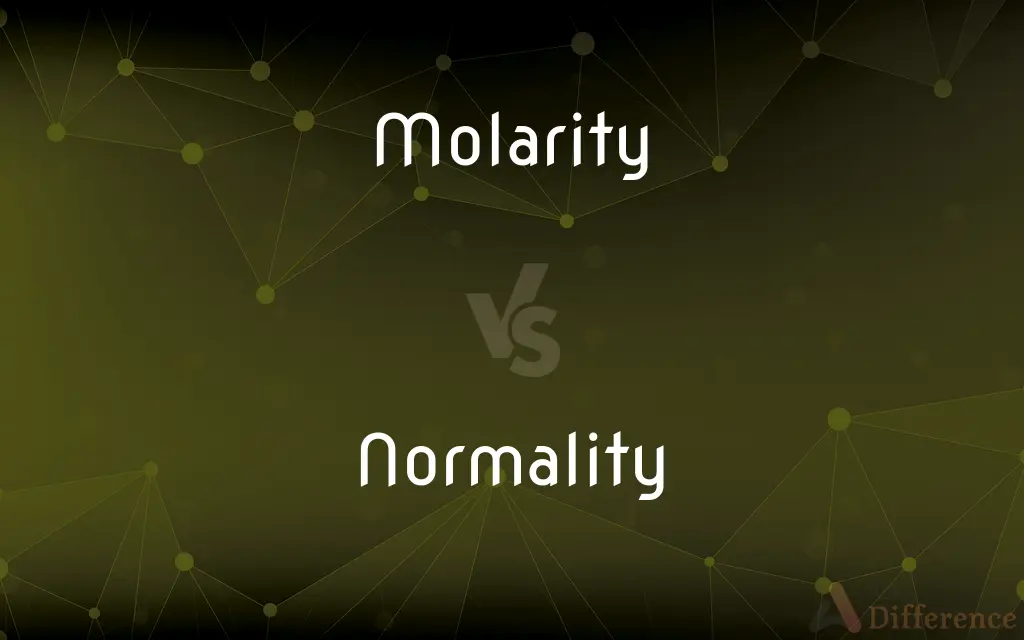Molarity vs. Normality — What's the Difference?
By Tayyaba Rehman — Updated on October 28, 2023
Molarity (M) measures moles of solute per liter of solution; Normality (N) measures equivalents of solute per liter of solution.

Difference Between Molarity and Normality
Table of Contents
ADVERTISEMENT
Key Differences
Molarity and Normality are both ways to express concentration in solutions, but they represent different things. While Molarity denotes the number of moles of solute in a liter of solution, Normality factors in the chemical reaction by measuring the number of reactive units.
In Molarity, it's about the total number of molecules of the solute, regardless of its properties. In contrast, Normality is specific to the reaction at hand, considering how a molecule behaves chemically, especially in acid-base reactions.
For example, sulfuric acid (H2SO4) can donate two hydrogen ions in a reaction. Its Molarity only considers the total molecules of H2SO4, but its Normality would be twice the Molarity because of the two reactive units.
Sometimes, Molarity and Normality can be the same, especially when dealing with substances that have only one reactive unit. However, they can differ when the solute has multiple equivalents.
Another distinction is that while Molarity remains constant regardless of the reaction, Normality can vary based on how the substance reacts in different scenarios.
ADVERTISEMENT
Comparison Chart
Definition
Moles of solute per liter of solution
Equivalents of solute per liter of solution
Dependency
Dependent on the number of molecules
Dependent on the number of reactive units
Example
1M HCl has 1 mole of HCl in 1L of solution
1N HCl has 1 equivalent of HCl in 1L of solution
Usage
Used universally for any solute
Common in titrations, especially acid-base
Relation
Always constant for a solute
Can vary based on the substance's reactivity
Compare with Definitions
Molarity
A concentration term representing moles of solute per liter of solution.
A 2M NaCl solution contains 2 moles of NaCl per liter.
Normality
A concentration term indicating equivalents of solute per liter of solution.
A 1N sulfuric acid solution donates 2 equivalents of protons.
Molarity
A standard unit to denote concentration in chemistry.
The reaction requires a 0.5M solution of potassium chloride.
Normality
Used predominantly in titration calculations.
For acid-base titrations, knowing the Normality is essential.
Molarity
A measure of solute quantity in relation to solution volume.
The Molarity of the sugar solution determines its sweetness.
Normality
Measure of active or reactive species in the solution.
While its Molarity is 1, the Normality of Ca(OH)2 is 2N because it can donate two OH- ions.
Molarity
An expression of concentration used in various chemical calculations.
Knowing the Molarity helps in predicting the reaction's outcome.
Normality
A reflection of the substance's reactivity in a solution.
The Normality of the acid solution indicates its strength.
Molarity
The ratio of moles of solute to liters of solution.
By increasing the solute, the Molarity of the solution increases.
Normality
An expression of concentration considering reactive units.
Normality is crucial when evaluating the reactivity of a solution.
Molarity
Abbr. M The concentration of a solution expressed in moles of solute per liter of solution.
Normality
The state or fact of being normal; normalcy.
Molarity
(chemistry) the concentration of a substance in solution, expressed as the number of moles of solute per litre of solution
Normality
Abbr. N(Chemistry) The concentration of a solution expressed as the number of gram equivalent weights of solute per liter of solution.
Molarity
Concentration measured by the number of moles of solute per liter of solvent
Normality
(uncountable) The state of being normal or usual; normalcy.
Jessie was going to wear pants to school, but her brother persuaded her to wear shorts to preserve normality.
Normality
(chemistry) The concentration of a solution expressed in gram equivalent weights of solute per litre of solution.
Normality
A measure of how well an observed distribution approximates a normal distribution.
Normality
Conformity with the norm; the state of being normal; the normal condition.
Normality
(of a solution) concentration expressed in gram equivalents of solute per liter
Normality
Being within certain limits that define the range of normal functioning
Normality
Expectedness as a consequence of being usual or regular or common
Normality
Conformity with the norm
Common Curiosities
Which is more specific to the reaction, Molarity or Normality?
Normality, as it considers the number of reactive units.
Which is used more in acid-base titrations, Molarity or Normality?
Normality is often used because of its relevance to reactive units.
Can Molarity and Normality be the same?
Yes, for substances with one reactive unit, Molarity equals Normality.
How do you convert Molarity to Normality?
Multiply Molarity by the number of equivalents or reactive units.
What does 1N mean in terms of Normality?
It means there's one equivalent of solute per liter of solution.
Why is understanding Normality important in titrations?
It helps determine the amount of solute needed for complete reaction.
How do you calculate Molarity?
Divide the number of moles of solute by the volume of the solution in liters.
Is Molarity used more frequently than Normality?
Yes, Molarity is more universal, while Normality is specific to certain types of reactions.
Are Molarity and molality the same?
No, Molarity is moles of solute per liter of solution, while molality is moles of solute per kilogram of solvent.
How does temperature affect Molarity?
Molarity can change with temperature due to volume changes in the solution.
Is Normality a measure of concentration or reactivity?
Both. It reflects concentration in terms of reactive units.
Can Normality be less than Molarity?
No, Normality is always equal to or greater than Molarity.
Is the concept of Normality applicable to all reactions?
No, it's mainly relevant for reactions where equivalents or reactive units matter.
Why isn't Normality always double the Molarity for H2SO4?
It's double only if both hydrogens of H2SO4 participate in the reaction.
Which is more affected by dilution, Molarity or Normality?
Both are affected equally by dilution.
Share Your Discovery

Previous Comparison
Resolution vs. Solution
Next Comparison
Inclusivity vs. InclusionAuthor Spotlight
Written by
Tayyaba RehmanTayyaba Rehman is a distinguished writer, currently serving as a primary contributor to askdifference.com. As a researcher in semantics and etymology, Tayyaba's passion for the complexity of languages and their distinctions has found a perfect home on the platform. Tayyaba delves into the intricacies of language, distinguishing between commonly confused words and phrases, thereby providing clarity for readers worldwide.















































